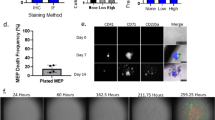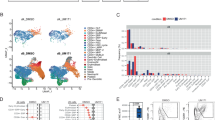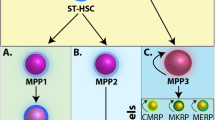Abstract
IT is generally accepted that in the haematopoietic system there is a hierarchy of pluripotent and committed progenitor cell types. Representative committed progenitors from all the myeloid and lymphoid pathways can be detected by in vitro colony assays1. This methodology has been extended to include multipotent haematopoietic progenitors2–5, and it has since been shown that at least one such multipotent cell type, the progenitor of macroscopic erythroid-megakaryocyte bursts, undergoes self-renewal during colony formation in vitro5. We now report that cells capable of macroscopic spleen colony formation (CFU-S)6 are present in macroscopic bursts and that on average two to three and up to five self-renewal divisions of CFU-S can occur during the first 9 d of burst growth. These findings raise the possibility that clonal analysis techniques7 may be combined with cell culture manipulations to investigate how the choice between self-renewal and progressive differentiation is determined.
This is a preview of subscription content, access via your institution
Access options
Subscribe to this journal
Receive 51 print issues and online access
$199.00 per year
only $3.90 per issue
Buy this article
- Purchase on SpringerLink
- Instant access to full article PDF
Prices may be subject to local taxes which are calculated during checkout
Similar content being viewed by others
References
Metcalf, D. Recent Results in Cancer Research: Hemopoietic Colonies (Springer, New York, 1977).
Johnson, G. R. & Metcalf, D. Proc. natn. Acad. Sci. U.S.A. 74, 3879–3882 (1977).
Hara, H. & Ogawa, M. Am. J. Hemat. 4, 23–34 (1978).
Fauser, A. A. & Messner, H. A. Blood 52, 1243–1248 (1978).
Humphries, R. K., Eaves, A. C. & Eaves, C. J. Blood 53, 746–763 (1979).
Till, J. E. & McCulloch, E. A. Radiat. Res. 14, 213–222 (1961).
Gregory, C. J. & Henkelman, R. M. in Experimental Hematology Today (eds Baum, S. J. & Ledney, G. D.) 93–101 (Springer, New York, 1977).
Gregory, C. J. & Eaves, A. C. in 5th Cold Spring Harbor Conference on Cell Proliferation, (eds Clarkson, B., Marks, P. A. & Till, J. E.) 179–192 (1978).
Dexter, T. M., Allen, T. D. & Lajtha, L. G. J. cell. Physiol. 91, 335–344 (1977).
Siminovitch, L., McCulloch, E. A. & Till, J. E. J. cell. comp. Physiol. 62, 327–336 (1963).
Nesbitt, M. N. & Francke, U. Chromosoma 41, 145–158 (1973).
Metcalf, D. & Moore, M. A. S. Hemopoietic Cells, 93–96 (North-Holland, Amsterdam, 1971).
Till, J. E., McCulloch, E. A. & Siminovitch, L. Proc. natn. Acad. Sci. U.S.A. 51, 29–36 (1964).
Curry, J. L., Trentin, J. J. & Wolf, N. J. exp. Med. 125, 703–720 (1967).
Metcalf, D., Johnson, G. R. & Mandel, T. E. J. cell. Physiol. 98, 401–420 (1979).
Author information
Authors and Affiliations
Rights and permissions
About this article
Cite this article
HUMPHRIES, R., JACKY, P., DILL, F. et al. CFU-S in individual erythroid colonies derived in vitro from adult mouse marrow. Nature 279, 718–720 (1979). https://doi.org/10.1038/279718a0
Received:
Accepted:
Issue date:
DOI: https://doi.org/10.1038/279718a0
This article is cited by
-
Methodology of long-term culture of human hemopoietic cells
Journal of Tissue Culture Methods (1991)



